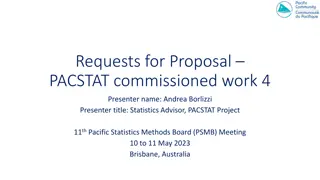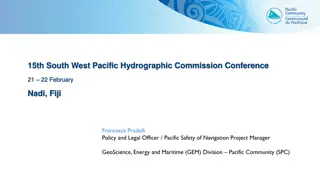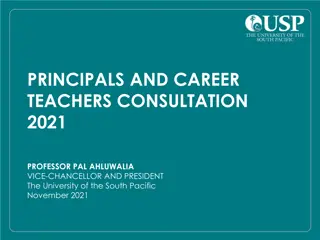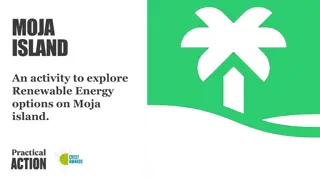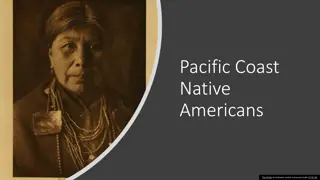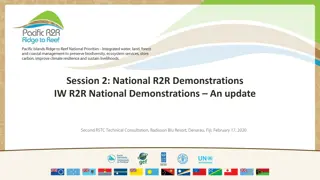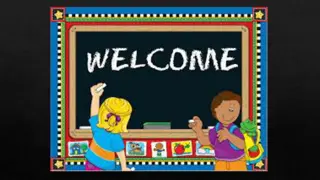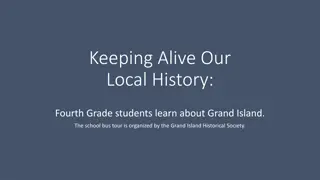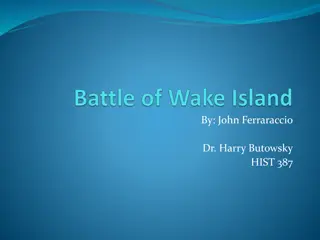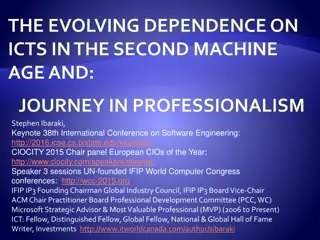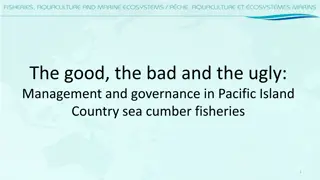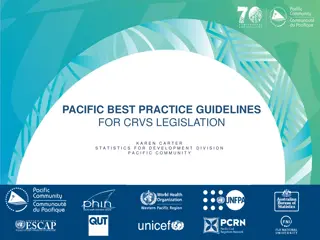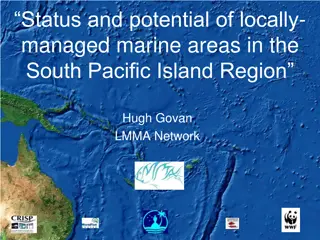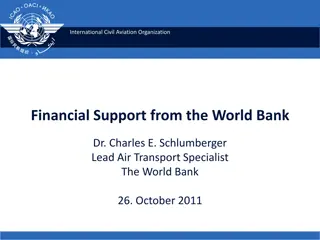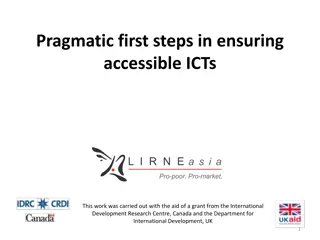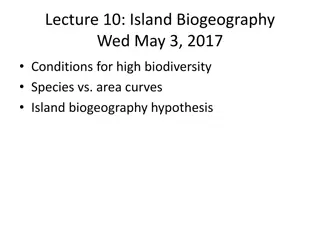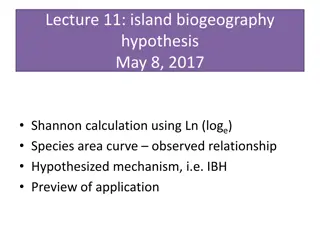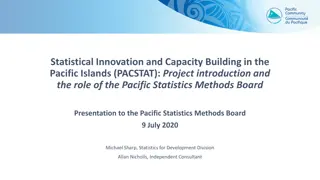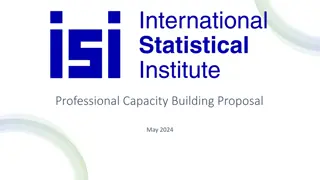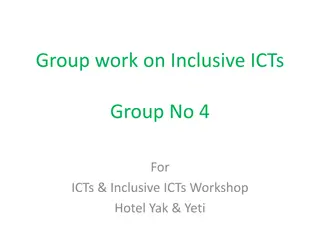Enhancing Service Delivery in Pacific Island Countries Through ICTs
This study delves into the use of Information and Communication Technologies (ICTs) to improve service delivery in the public sector of four Pacific Island Countries (PICs): Palau, Samoa, Kiribati, and the Solomon Islands. The study presents the current status of ICTs, identifies barriers impacting service delivery, offers recommendations to address these barriers, and provides insights on the future application of ICTs in these countries.
Download Presentation

Please find below an Image/Link to download the presentation.
The content on the website is provided AS IS for your information and personal use only. It may not be sold, licensed, or shared on other websites without obtaining consent from the author. Download presentation by click this link. If you encounter any issues during the download, it is possible that the publisher has removed the file from their server.
E N D
Presentation Transcript
Introduction This study explored the use of Information, Communication Technologies (ICTs) to enhance service delivery in the Public Sector of four Pacific Island Countries (PICs). The countries were Palau, Samoa, Kiribati and the Solomon Islands respectively. Specifically, the objectives of the study were to: present the current status of ICTs for service delivery in the public sector of selected countries; identify barriers to ICT use impacting service delivery; provide recommendations to address these barriers to effective ICT use; and provide a future outlook on the application of ICTs in selected countries. 2
Framework The framework for the study was conceptualized with the objectives in mind. The nature of ICT use in organisations in general provided an appropriate lens for examination via the RIPPLES model by Surry (2002) and Rogers (2003) Diffusion of Innovations (DoI) theory. Briefly, RIPPLES is a model organizations can use to plan for the successful implementation of new tools and practices. RIPPLES has seven components, namely, Resources, Infrastructure, People, Policies, Learning, Evaluation and Support. 3
Limitations Scope of theory Timeframe for Research Selected areas of Public Service Ethics Clearance Voluntary Participation 4
Snap Shots: Palau, Kiribati, Solomon Is, Samoa The nations and its people The economy The Public Service Telecommunications Profile 5
Methodology Mixed Methods Design (Quantitative and Qualitative) Phase 1 : In country interviews (Semi structured) Phase 2: Surveys (Online) Country Duration (2016) Samoa 25 29 April Kiribati 3 11 May Solomon Islands 16 20 May Palau 23 27 May 6
Study Sample Palau Samoa Kiribati Solomon Islands Education - 7 1 25 Health 2 2 1 - Information & Communication - 5 5 11 Public Service Office 3 11 3 - Grand Total 5 25 10 36
Findings 1. Characteristics of the sample; 2. Awareness of PICPA; 3. Extent of ICT use; 4. Access to ICTs; 5. ICT-related capabilities; 6. Plan for ICT use; 7. Types of ICT applications for service delivery; 8. Methods for evaluating service delivery; 9. Ways public gives feedback; 10. Means of informing public about introduction of new technologies; 11. RIPPLES assessment; 12. Views on ICT for service delivery; 13. Barriers to ICT use. 8
Recommendations Recommendation 1: Create, strengthen and engage ICT policies and strategies Create ICT polices and strategies both at the national and sectorial levels that is consistent and practical. Sectorial policies should be closely linked to national policy and vice versa. National ICT polices should be tied to the country s overall development plan/strategy and regional and international development priorities, e.g. PRISAP. Consider a centralized ICT body with relevant Terms of Reference to better coordinate, diffuse and monitor ICT policies and practices. 9
Recommendation 2: Enhance awareness and dissemination of information A proper communication plan needs to be in place for better dissemination of policies/plans across the Public Service and to the public. More community centres should be set up to provide access to ICT tools for greater awareness of public services. Information regarding public services should be more accessible in the local languages. Mobile applications should be further explored. Improve the methods for data storage of essential records across the Public Sector by hosting on properly maintained servers that enable easy intra-ministry sharing of information. Government portals for information need to be updated, consistent and maintained properly. Evaluation of processes, systems and services need to occur at regular intervals with a consistent approach
Recommendation 3: Develop infrastructure and resourcing capabilities A centrally coordinated audit of ICT infrastructure across the public service should be undertaken to map services provided to capacity to deliver in order to assess further steps to improve delivery. Consider infrastructure and resource sharing across ministries.
Recommendation 4: Alleviate cost and access issues Regulate the cost of standard ICT tools such as Internet access, mobile telephony and PCs/laptops to be more affordable to the public. Allow greater but monitored access to Internet use throughout the Public Service. Reduce the high cost of equipment and maintenance through subsidies for the public. Provide incentives for market entry of more ICT providers and remove the monopolistic approach to telecommunications provision. Explore the use of open source software and applications.
Recommendation 5: Focus on human resource development and retention Strengthen performance management systems for equitable opportunities and staff retention. Promote and encourage more ICT upskilling and workplace integration of ICT tools to bring about process efficiencies. Provide professional development and career plans for staff exploring cost effective means of upskilling such as undertaking relevant Massive Open Online Courses (MOOCs). Build a repository of relevant learning materials from Open Educational Resources (OER) related to the various sectors of the Public Service based on partnerships with regional and international organizations for the purpose of knowledge enhancement and sharing among ministries.
Palau Sample - 5 responses from Health (n=2) and Bureau of Public Service System (n=3) AWARENESS OF PICPA ACTIVITIES - PALAU USE OF ICT - PALAU 100% 80% Overall 20.00 80.00 66.67 60% 100.00 Public Service Office 100 40% 20% 33.33 Health 50.00 50.00 0% 0% 25% 50% 75% 100% Health Public Service Office Yes No Great extent Very great extent 16
ACCESS TO ICTS BY SECTOR - PALAU 100.00 Scanner 100.00 Printer Public Service Office 100.00 Mobile phone 100.00 Telephone - landline 100.00 Internet 100.00 Personal Computer 100.00 Scanner 100.00 Printer 100.00 Mobile phone Health 100.00 Telephone - landline 100.00 Internet 100.00 Personal Computer Yes No 0% 25% 50% 75% 100% 17
LEVEL OF CONFIDENCE IN VARIOUS TASKS - PALAU Download images from websites 80.00 20.00 Search for information using the Internet 80.00 20.00 Insert audio & video in a PowerPoint presentation 80.00 20.00 Insert text & images in a PowerPoint presentation 100.00 Create charts & graphs in a spreadsheet 80.00 20.00 TASKS Insert data in a spreadsheet 100.00 Insert, edit and format tables in a word document 100.00 Create a word document & format it 100.00 Create an email signature for my outgoing emails 60.00 20.00 20.00 Send an email with an attachment 80.00 20.00 0% 25% 50% 75% 100% Totally confident Moderately confident Not at all confident 18
EXISTENCE OF AN ICT PLAN/POLICY - PALAU 100.00 66.67 33.33 HEALTH PUBLIC SERVICE OFFICE Yes No Not Sure 19
Types of ICT applications for service delivery Radio Television Website Cell Landline phones Email notifications. 20
Methods for evaluating service delivery Written feedback There did not appear to be a systematic or singular preferable method however so various avenues appeared to be acceptable as long as the office/department was contactable ..Respondent C WAYS PUBLIC GIVE FEEDBACK - PALAU 100% 33.33 80% 50.00 60% 40% 66.67 50.00 20% 0% Health Public Service Office Feedback via email Submit comments on website Verbal feedback 21
MEANS OF INFORMING PUBLIC ABOUT INTRODUCTION OF NEW TECHNOLOGIES - PALAU Public Service Office 33.33 33.33 33.33 Health 50.00 50.00 0% 25% 50% 75% 100% Hard-copy printed information Website Formal meetings and information sessions Other Email Word of mouth (Informal) Radio 22
Views on ICT for service delivery Importance - respondents acknowledged its vitality to a changing world and the fact that more knowledge in terms of know how is needed in order for enhanced use of ICTs. Cost respondents felt that access to computers for example needed to be cost effective, even free. Along with this sentiment was the need for affordable and faster internet connectivity. The interviews pointed to similar themes in terms of having better connectivity and less of a monopolized approach to internet (and telecommunications) provisions. Effectiveness - they saw ICT use as positive in terms of being immediate, relevant and allowing for greater coverage of the population as far as dissemination of information was concerned. 23
Barriers to ICT use Overall, poor, limited or underdeveloped infrastructure coupled with limited access to computers (and the internet) because of high costs hindered widespread use of ICTs. Lack of development as far as infrastructure goes. Internet is quite slow, for example, I had to do this survey four times before it sent through. A large part of the community does not have access to fast internet that is readily available Respondent x. 24
Samoa Sample - 25 participants from 4 sectors: 1. 2. 3. 4. Education (n=7) Health (n=2) Information and Communication (n=5) Public Service Office (n=11) AWARENESS OF PICPA ACTIVITIES - SAMOA USE OF ICT - SAMOA 100% 80% 42.86 45.45 Overall 36.00 64.00 60% 100.00 100.00 40% Public Service Office 63.00 37.00 45.45 57.14 20% Information & 40.00 60.00 9.10 0% Health 100.00 Education 100.00 0% 25% 50% 75% 100% Moderate extent Great extent Very great extent Yes No 25
ACCESS TO ICTS BY SECTOR - SAMOA Scanner 90.90 9.10 Public Service Office Printer 90.90 9.10 Mobile phone 63.63 36.37 Telephone - landline 100.00 Internet 100.00 Personal Computer 100.00 Scanner 100.00 Communication Information & Printer 100.00 Mobile phone 60.00 40.00 Telephone - landline 100.00 Internet 100.00 Personal Computer 100.00 Scanner 50.00 50.00 Printer 50.00 50.00 Health Mobile phone 100.00 Telephone - landline 50.00 50.00 Internet 100.00 Personal Computer 100.00 Scanner 85.71 14.29 Printer 100.00 Education Mobile phone 85.71 14.29 Telephone - landline 100.00 Internet 100.00 Personal Computer 85.71 14.29 0% 25% 50% 75% 100% Yes No 26
LEVEL OF CONFIDENCE IN VARIOUS TASKS - SAMOA Download images from websites 92.00 8.00 Search for information using the Internet 96.00 4.00 Insert audio & video in a PowerPoint presentation 72.00 16.00 12.00 Insert text & images in a PowerPoint presentation 92.00 8.00 Create charts & graphs in a spreadsheet 84.00 16.00 TASKS Insert data in a spreadsheet 92.00 8.00 Insert, edit and format tables in a word document 100.00 Create a word document & format it 100.00 Create an email signature for my outgoing emails 92.00 8.00 Send an email with an attachment 92.00 8.00 0% 25% 50% 75% 100% Totally confident Moderately confident Not at all confident 27
EXISTENCE OF AN ICT PLAN/POLICY - SAMOA 81.82 80.00 57.14 50.00 50.00 28.57 20.00 18.18 14.29 EDUCATION HEALTH INFORMATION & COMMUNICATION PUBLIC SERVICE OFFICE Yes No Not Sure 28
Types of ICT applications for service delivery Respondents commonly listed several types of ICT applications as listed in slide # 26. Additionally, there were mentions of mass media tools such as radio and TV. Email and websites were also mentioned along with specific sector based tools such as hospital databases. e-Survey platforms and social media such as Twitter and Facebook. 29
Methods for evaluating service delivery email and telephone surveys and public consultations or receipt of public complaints directly. Additionally there were mentions of regular reporting systems such as an outcomes based template to note the quality of services provided monitoring of website hits and social media comments. 30
WAYS PUBLIC GIVES FEEDBACK - SAMOA 100% MEANS OF INFORMING THE PUBLIC ABOUT NEW TECHNOLOGIES - SAMOA 90% 20.00 28.57 36.37 80% 50.00 Public Service Office 9.09 27.28 9.09 18.18 18.18 18.18 70% 60% 40.00 Information & Communication 60.00 40.00 18.18 50% 42.85 9.09 40% Health 50.00 50.00 9.09 30% 50.00 14.29 20% 40.00 Education 28.56 14.29 42.86 14.29 18.18 10% 14.29 0% 25% 50% 75% 100% 9.09 0% Hard-copy printed information Email Website Word of mouth Other Hardly provide feedback Feedback over the phone 31
Views on ICT for service delivery +ve effectiveness, efficiencies and usefulness. The importance was also emphasized in terms of this day and age of progress and organizational change -ve slow connectivity, further room needed for improvement in ICT use, a lack of full capacity in terms of proper use and the need for more public exposure to ICT use. 32
Barriers to ICT use Affordability & lack of or inequitable funding (opportunities) for enhanced infrastructure, equipment, acquisition of new technologies and maintenance costs. Lack of knowledge/understanding ( literacy ), buy-in, confidence, the limited access to ICTs. The number one barrier is the current mindset of the users who have a negative attitude in opening up and accepting these new technologies to change how we transact and interact. Therefore, we need to educate them and make them aware of these changes illustrating the benefits that they can have when they follow along. The second issue is lack of funding sources. ICT is a cost centre and equipment and softwares/systems are not cheap to procure. Also, ICT experts are limited. Respondent Y. 33
Kiribati Sample -10 participants from 4 sectors Education (n=1) Health (n=1) Information & Communication (n=5) Public Service Office (n=3) AWARENESS OF PICPA ACTIVITIES - KIRIBATI USE OF ICT - KIRIBATI 100% 80% 40.00 60% Overall 50.00 50.00 100.00 100.00 20.00 100.00 40% Public Service Office 100.00 20% 40.00 0% Information & 40.00 60.00 Health 100.00 Education 100.00 Moderate extent Great extent 0% 25% 50% 75% 100% Very great extent Yes No 34
ACCESS TO ICTS BY SECTOR - KIRIBATI Scanner 66.67 33.33 Public Service Office Printer 100.00 Mobile phone 66.67 33.33 Telephone - landline 100.00 Internet 100.00 Personal Computer 100.00 Scanner 80.00 20.00 Communication Information & Printer 100.00 Mobile phone 80.00 20.00 Telephone - landline 100.00 Internet 100.00 Personal Computer 100.00 Scanner 100.00 Printer 100.00 Health Mobile phone 100.00 Telephone - landline 100.00 Internet 100.00 Personal Computer 100.00 Scanner 100.00 Printer 100.00 Education Mobile phone 100.00 Telephone - landline 100.00 Internet 100.00 Personal Computer 100.00 Yes No 0% 25% 50% 75% 100% 35
LEVEL OF CONFIDENCE IN VARIOUS TASKS - KIRIBATI Download images from websites 70.00 20.00 10.00 Search for information using the Internet 90.00 10.00 Insert audio & video in a PowerPoint presentation 50.00 30.00 20.00 Insert text & images in a PowerPoint presentation 80.00 10.00 10.00 Create charts & graphs in a spreadsheet 70.00 10.00 20.00 TASKS Insert data in a spreadsheet 70.00 10.00 20.00 Insert, edit and format tables in a word document 90.00 10.00 Create a word document & format it 90.00 10.00 Create an email signature for my outgoing emails 50.00 30.00 20.00 Send an email with an attachment 90.00 10.00 0% 25% 50% 75% 100% Totally confident Moderately confident Not at all confident 36
EXISTENCE OF AN ICT PLAN/POLICY - KIRIBATI 100.00 100.00 66.67 40.00 40.00 33.33 20.00 0.00 EDUCATION HEALTH INFORMATION & COMMUNICATION PUBLIC SERVICE OFFICE Yes No Not Sure 37
Types of ICT applications for service delivery Emails, Website Telephony Internet connectivity appeared to be key in allowing communication exchanges and ministries keeping abreast of the issues arising from time to time. 38
Methods for evaluating service delivery Unspecified survey type instruments Email feedback Complaint boxes. There were also indications of some form of interviews and staff performance measures. WAYS PUBLIC GIVE FEEDBACK - KIRIBATI 100% 90% 20.00 80% 70% 20.00 66.67 60% 50% 100.00 100.00 40% 40.00 30% 20% 33.33 10% 20.00 0% Education Health Information & Communication Public Service Office Feedback via email Verbal feedback Submit comments on website Feedback over the phone 39
MEANS OF INFORMING THE PUBLIC ABOUT INTRODUCTION OF NEW TECHNOLGIES - KIRIBATI Public Service Office 100.00 Information & Communication 20.00 20.00 40.00 20.00 Health 100.00 Education 100.00 0% 25% 50% 75% 100% Hard-copy printed information Website Formal meetings and information sessions Other Email Word of mouth (Informal) Radio 40
Views on ICT for service delivery the potential and capabilities of ICT use, to enhance the effectiveness and efficiency of the service delivery to the public capacity to reach remote islands where it was not possible before I believe ICT is enabling us to shape our future using new innovations and technology although at present this potential is benefitting us averagely but can be further improved by providing the support needed for ICT to be integrated constructively into how we carry out our duties within our respective departments as well as when dealing with customers and also between staff in this Ministry. Respondent A 41
Barriers to ICT use Cost - monopolized telecommunications environment, e.g. high cost of internet connection. Access access by the general population, especially to access government information relevant to them Connectivity especially to remote islands Capability lack of basic ICT skills 42
Solomon Islands Sample 36 participants from 2 sectors Education (n=25) Information & Communication (n=11) AWARENESS OF PICPA ACTIVITIES - SOLOMON ISLANDS USE OF ICT - SOLOMON 100% 80% 40.00 Overall 13.80 86.20 63.64 60% Information & Communication 9.10 90.90 36.00 40% 18.18 Education 16.00 84.00 20% 20.00 9.09 9.09 4.00 0% 0% 25% 50% 75% 100% Education Information & Communication Yes No A small extent Some extent Moderate extent Great extent Very great extent 43
ACCESS TO ICTS BY SECTOR - SOLOMON ISLANDS Scanner 100.00 Information & Communication Printer 100.00 Mobile phone 100.00 Telephone - landline 100.00 Internet 100.00 Personal Computer 100.00 Scanner 100.00 Printer 100.00 Education Mobile phone 92.00 18.00 Telephone - landline 100.00 Internet 100.00 Personal Computer 96.00 4.00 Yes No 0% 25% 50% 75% 100% 44
LEVEL OF CONFIDENCE IN VARIOUS TASKS - SOLOMON ISLANDS Download images from websites 77.78 19.44 2.78 Search for information using the Internet 86.11 13.89 Insert audio & video in a PowerPoint presentation 50.00 33.33 16.67 Insert text & images in a PowerPoint presentation 69.44 22.22 8.34 Create charts & graphs in a spreadsheet 58.33 30.56 11.11 TASKS Insert data in a spreadsheet 72.22 25.00 2.78 Insert, edit and format tables in a word document 80.56 13.89 5.55 Create a word document & format it 88.89 8.33 2.78 Create an email signature for my outgoing emails 75.00 13.89 11.11 Send an email with an attachment 94.44 5.56 0% 25% 50% 75% 100% Totally confident Moderately confident Not at all confident 45
EXISTENCE OF AN ICT PLAN/POLICY - SOLOMON ISLANDS 81.82 56.00 28.00 18.18 16.00 EDUCATION INFORMATION & COMMUNICATION Yes No Not Sure 46
Types of ICT applications for service delivery Emails Website Telephony Sector Specific Databases 47
Methods for evaluating service delivery Electronic means (Helpdesk System) Hard Copy There did not appear to be any singular or standard method for evaluating service delivery. 48
WAYS PUBLIC GIVE FEEDBACK SOLOMON ISLANDS 100% 9.09 90% 36.00 80% 70% 60% 16.00 50% 90.91 40% 16.00 30% 20% 24.00 10% 8.00 0% Education Information & Communication Feedback via email Submit comments on website Verbal feedback Feedback over the phone Hardly provide feedback Other 49
MEANS OF INFORMING THE PUBLIC ABOUT THE INTRODUCTION OF NEW TECHNOLOGIES SOLOMON ISLANDS Information & Communication 9.09 63.64 9.09 18.18 4.00 Education 12.00 8.00 48.00 24.00 4.00 0% 25% 50% 75% 100% Hard-copy printed information Website Formal meetings and information sessions Other Email Word of mouth (Informal) Radio 50


